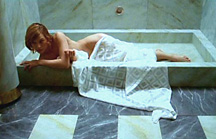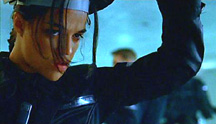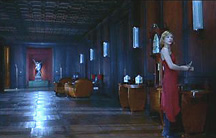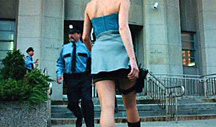JUMP CUT
A
REVIEW OF CONTEMPORARY MEDIA
![]()

Holographic representation of Resident Evil’s Red Queen computer: Although references to philosophical notions such as the Red Queen Principle raise the first film’s cultural capital, both films deal more with action than ideas.


Resident Evil poster featuring a blindingly white Milla Jovovich and Michelle Rodriguez with her trademark scowl.


Nude awakening: Alice's first scene in Resident Evil — about which Jovovich ironically remarks: "I just love to do those gratuitous nudity scenes."


Like Vasquez in Aliens (1986), Rain is a sultry Latina sidekick.


Rain is coded as "masculine," partly through her job as an engineer...


…and partly through her military prowess.


"Jumpy?" Rain is teased on account of her supposed nervousness…


...but she quickly turns the tables on her tormentor, when his own nerved are tested. The reversal replays the sparring between Vasquez and Hudson in Aliens (1986).


Alice, meanwhile, is overdetermined as middle class both by her cocktail dress and by the opulent mise-en-scčne of her early scenes.


Alice and Rain share a brief tender moment in the train.




Matt looks on, helping to unqueer the encounter.


"Imagine a world where you can reverse the effects of age, stress and sun."The teaser trailer for Apocalypse takes the form of sinister advertisement for Umbrella Corp’s beauty product Regenerate.


"Regenerate’s revolutionary T-cell formula actually brings dead cells back to life."


"Now your youthful beauty can last forever."


"Some side effects may occu." The ad shifts in tone as the model’s face begins to crack horrifically. The teaser trailer suggests a feminist critique of the beauty myth that does not materialize in the film itself.


Best foot forward: The first shot of former police officer Jill Valentine in Resident Evil: Apocalypse.


As the zombie chaos begins, Jill shimmies back to her former precinct.


Cop this… The first shot of Jill as she enters the police station.


The camera also frequently tracks Alice's body from behind, fetishizing her body.


Alice and Jill — together, but apart. There is little camaraderie between the leading females.


Jill locates Angie Ashcroft…


…and becomes her protector.


Alice also plays mom, reinforcing action cinema's gendered division of emotional labor.


Despite the films’ phallocentric mode of address, patriarchy is attacked throughout both films. Here, Resident Evil’s traitor gets it in the neck…


…while Ginovaeff’s ineffectual seduction signals the redundancy of patriarchy in Apocalypse.


Drop dead gorgeous. Alice returns the security guard's gaze...


...with deadly consequences.




In all his naive liberalism, Matt is the acceptable face of masculinity in Resident Evil.

"I could kiss you, you bitch."
Race, gender and sexuality
in Resident Evil and
Resident Evil 2: Apocalypse
Resident Evil and Resident Evil 2: Apocalypse are the first two films in the ongoing Resident Evil series. They are also among the latest examples of action films based on video games — a subgenre including Resident Evil director Paul W. S. Anderson’s previous film Mortal Kombat (1995) and the Lara Croft films, subtitled Tomb Raider (West, 2001) and Cradle of Life (de Bont, 2003) respectively. The two directors of the Resident Evil films (Anderson and Witt) have created films that are rather distinct in terms of atmosphere and pace.
As Bob Rehak (2003) [open works cited in new window] has pointed out, the first of the films – Resident Evil (Anderson, 2002) – is a narratively and generically simple action film "pieced together from Aliens (1986), Night of the Living Dead (1990), Predator (1987), even Die Hard (1988)." It eschews the moral and intellectual sophistry of much recent action and science fiction cinema, such as that of the Matrix films. Yet despite its conceptual simplicity, the film does make a fair bid for cultural capital with its numerous references to Lewis Carroll’s Alice’s Adventures in Wonderland and Through the Looking Glass (which were added by Anderson and are not present in the video game). A chess motif also runs throughout the film, while the computer that controls the underground Hive entered by the team in the film is called the "Red Queen." The computer's name refers to the Red Queen Principle proposed by evolutionary biologist Leigh van Valen in 1973 to describe the fact that evolutionary systems must continually develop just to maintain their fitness relative to the systems with which they are co-evolving (Van Valen, 1973). Together with the Alice references, this allusion lends cultural cachet to what might otherwise be considered (as zombie films so often are) formulaic and mediocre. Resident Evil 2: Apocalypse (Witt, 2004), while narratively closer to the video games than the first film, substitutes fast-moving action for the claustrophobic intensity and intellectual pretensions of its precursor.
Despite such differences, both of the Resident Evil films can be seen as postmodern and postfeminist texts insofar as they help to generate commercial synergy with the video games on which they are based. They also present a highly ambiguous perspective on corporate power as well as on issues of race, gender and sexuality. This short paper offers a critique of the gender, sexual and racial politics of these films, focusing mainly on the leading female characters of the two films – Alice (Milla Jovovich), Rain (Michelle Rodriguez) and Alice’s accomplice in the sequel, Jill (Sienna Guillory). The article combines critical textual analysis with extra-textual evidence – including film reviews and actor interviews – to illuminate what I argue are racist, sexist and homophobic elements within the films.
Along the way, the paper compares the representational strategies of these films with those of other action movies of the 1980s and 1990s; as noted in the quotation above, Resident Evil, in particular, draws heavily upon the action cinema of the last twenty years. I will also draw comparisons with the hugely popular television drama Buffy the Vampire Slayer, on the grounds that, like the contemporary Resident Evil films, Buffy is a text which combines representations of violent and confident femininity with problematic constructions of gender, race and sexuality. These comparisons, I hope, will help to illuminate how the films – despite containing some feminist and other progressive representational strategies – deploy stereotypes of gender, race and sexuality. The paper concludes by comparing the racial, sexual and gender politics of the Resident Evil films and those of other zombie films past and present, particularly the films of George Romero.
"I just love to do those gratuitous nudity scenes" — gender, sexuality and irony
Promotional texts surrounding both Resident Evil and Apocalypse trade on sexually alluring images of their female leads. In the case of the first film, billboards and other promotional materials depicted a sultry Milla Jovovich in a cocktail dress and black knee-length boots wielding an enormous weapon, with Michelle Rodriguez striking her skulking signature pose behind Jovovich — and in the process exemplifying the film’s hierarchical structuring of racial identity. Alice’s weapon can be read as a phallic symbol and the stances of both women characterizes them as "figurative males." [1] [open notes in new window] Yet for all their dynamism, these heroines are also presented as hypersexualized spectacles, both in the promotional texts and in the films. Both films certainly offer no narrative rationale for Alice’s glamorous attire.
Jovovich and Rodriguez are differentiated in ways that are consistent with their respective Hollywood careers. Jovovich’s Alice is a glamour girl in a cocktail dress, reflecting her real-life role as one of the "faces" of L’Oreal cosmetics. Like that other horror-femme actress-model, Buffy the Vampire Slayer’s Sarah Michelle Gellar, Jovovich’s association with glamour and fashion serve to fetishize her screen character, a process sustained in the film narrative. In her first scene in Resident Evil, for example, the camera lingers on Alice as she wakes up naked in a shower cubicle. Jovovich herself is aware that such representations are problematic. In the DVD commentary accompanying the shower scene, she comments sardonically:
"I just love to do those gratuitous nudity scenes."
This seemingly post-feminist irony suggests an ambivalence about (and certainly not a rejection of) sexualized representations of women. Elsewhere on the same DVD commentary Jovovich remarks:
"If you guys make this movie a huge hit … we can all get breast enhancement surgery."
In another interview Jovovich states that she thought of herself in the film as "a young Sigourney Weaver" and even designed a gown for the film with the intention of recreating the feel of the underwear outfit from the controversial closing scenes of Ridley Scott’s 1979 sci-fi classic Alien (Hayward, 2002). Such statements undermine any simplistic notion that female actresses are objectified against their will by male filmmakers. The DVD commentaries for both of the Resident Evil films clearly indicate the extent to which the films’ female stars relish and identify with the hypersexualized femininity of their screen characters.
Rodriguez’s character, Rain Ocampo, was originally written by Anderson for a male actor. Indeed, of all the female characters in the Resident Evil films, Rain, whether shooting zombies or wielding power tools, is the one most clearly coded as "masculine." An analogy with the Alien films is instructive here, since Rain’s spikiness owes a cinematic debt to the assertive Vasquez (Jenette Goldstein) in James Cameron’s Aliens (1986), another "brassy" Latina sidekick. In the tense opening scenes of Resident Evil, Rain is teased by a male colleague who asks if she isn’t a little "jumpy." A few scenes later, however, Rain turns the question on her colleague after she saves him from a zombie attack. There is a close similarity here with the much-celebrated sparring between Private Hudson (Bill Paxton) and Vasquez in Aliens ("Hey, Vasquez, have you ever been mistaken for a man?"; "No, have you?"). Rain’s characterisation, like so much in this film, borrows heavily from action cinema’s stock of progressive gender stereotypes.
Rodriguez seems consummately aware of her hardboiled image in Resident Evil, arguing in an interview that
"men just like to see women as sexy, whether they’re strong or weak, and my characters appeal to certain types of men" (Hayward, 2002).
Like Jovovich’s intention to design a gown based on Ripley’s provocative underwear in Alien, this may be seen as a postfeminist statement. Rodriguez conceives of her filmic appearance primarily in terms of (heterosexual) male approbation. In the same interview, Rodriguez invokes the discourse of marketing to explain both her personal and her professional life, noting that she has acquired a "niche" in Hollywood for playing strong women and is consequently often asked out by "biker types."
Clearly, while Alice and Rain are both "strong women," they are consciously differentiated on the basis of a time-honoured goodie girl/tough girl dyad. This dyad, which corresponds to the Dark Lady/Fair Lady dichotomy of Western literature (Greven, 2004: 140), finds expression in films as diverse as Grease (Kleiser, 1978) and Thelma and Louise (Scott, 1992). As in those films, the moral demarcation of "good" and "bad" girls loosely corresponds to distinctions of race and social class. In relation to historical precedents within action cinema, the example of the Alien series is once again instructive. In Alien, Ripley is coded as a middle class woman by her clipboard and only later in the film takes up arms, while Vasquez, in Aliens, is an acerbic gun-toting heroine from the outset. Resident Evil replicates this pattern: Alice carries no weapon in the first part of the film and is coded as middle class by her cocktail dress, while Rain, an engineer, undertakes both maintenance work and hardcore action and consistently speaks in a working class register ("When I get outta here, I think I’m gonna get laid").
For all of the film’s "compulsory heterosexuality" and Rodriguez’s anxious insistence on her allure to men, Resident Evil offers a fleeting lesbian moment. Towards the end of the film Alice tends to Rain, who has been bitten by a zombie, declaring:
"I could kiss you, you bitch."
Mindful of their mainstream audience, the filmmakers ensure that while Alice could kiss Rain, she does not. In fact, the film mitigates any potential homoeroticism in a number of ways. First, any eroticism implied in Alice’s comment is subtly defused by the reaction of her colleague Matt Addison (Eric Mabius), who stands in the background of the shot. Although out of focus, Matt is clearly smiling in kindly, even paternalistic approbation at Alice’s comment, gently de-sexualizing the moment. Second, Alice’s use of the term "bitch" arguably endows her with a masculine, heterosexual subject position, helping to un-queer the encounter. The intimacy between Alice and Rain is also rendered respectable by the nature of Rain’s transformative sickness, which confers upon her a temporary otherness. Finally, the incipient lesbian moment is predictably interrupted by the intrusion of the vicious "Licker" monster, whose arrival demands the full attentions of all the survivors. Thus the potentially disruptive outburst of homosexual desire is neutralized and "othered" by the unusualness and extremity of the situation.
Such recuperation of homosexual potential is of course a feature of many Hollywood films. In Girl Interrupted (Mangold, 1999), for example, the kiss between Susanna (Winona Ryder) and Lisa (Angelina Jolie) occurs in a psychedelically-painted VW camper van while the pair are under the influence of psychoactive drugs. In Thelma and Louise (Scott, 1992) the significance of the famous kiss is largely vitiated by the heroines’ subsequent decision to drive their car into the Grand Canyon. Similarly, Alice and Rain’s fleeting moment of intimacy does not undermine the film’s heterosexual ethic or the "straight" credentials that the actresses have worked so hard to establish in their promotional interviews. As in Thelma and Louise, the "queer" kiss is swiftly followed by death. During the fight against the Licker, Rain finally turns into a zombie, before Matt puts her out of her misery. As it is for action heroines on television, such as Buffy, Xena, or Sydney Bristow, desire – whether hetero- or homosexual – is endlessly deferred.
Before its release, there was reason to believe that Resident Evil 2: Apocalypse would develop politically progressive and even feminist themes. Sony Pictures’ theatrical trailer for the film darkly intones that,
"in the quest for human perfection, accidents will happen."
A teaser trailer for the film contains a spoof cosmetics commercial for the Umbrella Corporation, the mega-corporation responsible for the viral outbreak that is causing human beings to transform into zombies. The words of the commercial are delivered by over an ambient soundtrack by a sinisterly melodious female voice:
"Imagine a world where you can reverse the effects of age, stress and sun. From the leading name in biotechnology comes Regenerate, another breakthrough from the Umbrella Corporation. Regenerate’s revolutionary T-cell formula actually brings dead cells back to life. Now, your youthful beauty can last forever. Always consult your doctor before starting treatment; some side effects may occur."
The final, ominous injunction indicates the inevitably of a disaster, recalling the progressive horror and sci-fi of the 1970s, in which such cool corporate blandishments and reassurances are swiftly followed by catastrophe (compare the hilariously unconvincing tannoy announcement in Michael Crichton’s pre-Jurassic Westworld [1973]: "Nothing can go wrong"). On the evidence of this trailer, Resident Evil 2: Apocalypse promises to be more progressive than its predecessor. The trailer suggests that the film will contain not only a critique of the power of the evil Umbrella Corporation, but also a second wave feminist broadside against the "beauty myth," along the lines of that advanced by Naomi Wolf (1991).
However, the "beauty myth" critique is not developed in the film. This can perhaps be explained in terms of promotional strategy. The feminist implications of the teaser trailer might have been intended to attract audiences seeking a "social message" horror film, as opposed to those looking for a "gorefest’; since, in the case of the Resident Evil films, the latter audience is almost guaranteed, their needs are hardly uppermost in the minds of marketers. Whatever the reasons for the disjunction between the film and its feminist promotional material, the trailer’s feminist intimations are not realized. On the contrary, I will argue that any feminist aspects of the film are significantly compromised, if not entirely recuperated. What is interesting about the trailer, however, is that – like the ironic interview comments made by the Resident Evil actresses – it attests to a distinct, yet ironic and ambivalent awareness of feminist concerns.
In Apocalypse, both of the leading female characters could be argued to be objectified through their Lara Croft-style wardrobe of short skirts or shorts and tight vest tops. A somewhat spurious rationale for the revealing clothing of the central characters is introduced (apparently, according to the DVD interview, at Jovovich’s suggestion): namely, that Racoon City is experiencing a heat wave. Yet this attempt to provide a diegetic explanation for the women’s clothing is itself rather threadbare, and it only draws attention to the sensationalism of the filmic dress code.
Camerawork is also important in fetishizing the (white) female characters. In the first scene featuring Jill Valentine, we do not see the character’s face at all. Instead, the camera follows her naked legs, which are exposed by her mini skirt. (Valentine wears the same mini skirt and blue tube top outfit that she wears in Capcom’s Resident Evil: Nemesis videogame.) In the following scene, in which Jill reports to the police station overrun by zombies, the initial sequence is shot from a low angle to capture Jill’s buttocks and legs as she shimmies towards the station. In both films, the camera frequently tracks the heroines from behind, fetishizing their lithe bodies.
The relationship between Alice and Jill in Apocalypse is distinctly cooler than that between Alice and Rain in the first film. Unlike the more hierarchical relationship between Alice and Rain, Alice and Jill are presented as near-equals — although Jill is forced to concede a hierarchy on witnessing Alice’s prowess in combat, remarking "I’m good – but I’m not that good." Perhaps because of this competitive element, there is even less camaraderie between the two heroines in the sequel than in the first film; as in the videogame upon which the film is based, the two women hardly ever interact. This is consistent with Yvonne Tasker’s observation that
"though the elaborate description of sentimental, homoerotic relationships between men is commonplace in the popular cinema, the successful female partnerships of Thelma and Louise or the television police duo Cagney and Lacey, for example, have generated in their wake no new wave of female buddy movies or television series" (Tasker, 1998: 140).
While the last few years have seen some developments along these lines (McG’s 2000 film version of Charlie’s Angels and its 2003 sequel are notable examples), Tasker’s observation generally holds true. Certainly, Alice and Jill remain more or less separate throughout the course of Apocalypse. Even in those scenes in which both characters are present, there is no banter or bonding, and little co-operation between them.
Although they operate separately rather than in tandem, both of Apocalypse’s female protagonists adopt a maternal role, as Jill and Alice seek out and rescue Angie (Sophie Vavasseur), the young daughter of Umbrella Corporation’s heroic scientist Dr Ashford (Jared Harris). The protective and nurturing relationship between the two heroines and Angie Ashford recalls that between Ripley and the young Rebecca Jordan (Carrie Henn, also known in the film as "Newt’) in Aliens. In addition to a readiness for violence, it seems that the action heroine must also show a flair for motherhood: Uma Thurman’s The Bride, in Quentin Tarantino’s Kill Bill: Vol. 2 (2004), is a recent example of an action heroine who, having adopting various roles throughout the film, finally yields to her biological "destiny" as mother. (This message is reinforced by the pro-life message of the Japanese hotel room scene in the same film, in which The Bride pleads for her life on the basis that she is pregnant.) Indeed, like so many "kick ass" heroines in contemporary action cinema, Alice and Jill, unlike the male characters in the film, adopt a parental role.
The Resident Evil films are not, however, entirely without feminist import. First, the heroines of these films are not punished for their transgression of gender norms, insofar as they actually do transgress them. Moreover, patriarchal power is threatened or at least undermined at several points. In Resident Evil, the traitor Spence (James Purefoy) is bitten by a female zombie when he reveals his treachery to Alice. In Apocalypse, meanwhile, Sergeant Nicholai Ginovaeff (Zack Ward) helps to save Jill and Angie Ashford from marauding zombie dogs. Afterwards, he introduces himself, somewhat smarmily, to Jill, but is attacked and killed by a lingering hound before he has a chance to complete his seduction. The unexpected intrusion of the dog attack into the hackneyed seduction scene, together with the ludicrously swift destruction of the patriarchal "protector," humorously undermines the sergeant’s flagrant machismo. Indeed, Ginovaeff’s demise can be read as the death of a patriarch. As the sergeant fights with the dog he shouts to Jill:
"Take the girl; I’ve got this bitch" (my italics reflect the spoken emphasis).
The implied equation between Angie Ashford and the dog ensures that the destruction of this sexist male provides a moment of anti-patriarchal pleasure.
This anti-patriarchal sensibility is evident in the violence actions of the genetically enhanced Alice at the end of Apocalypse. In the slightly confusing scenes after the team has escaped from Racoon city and saved Angie, Alice finds herself inside a tank, under the supervision of Umbrella Corporation scientists at the Umbrella Medical Research facility. Her physical and mental powers, one of Umbrella scientists observes, have been massively augmented. When she is removed from the tank, Alice attacks a young male scientist, thrusting a pen towards his eye. A close-up shot shows the pen as Alice brings its tip to rest, just before it pierces the scientist’s eye. Although Alice elects to beat up, rather than mutilate, the scientist in order to escape from the facility, the threatened ocular penetration conveys Alice’s rejection of, and opposition to, the male gaze, and it recalls the classic Freudian linkage of the castration complex to the male fear of damage to the eyes.
Afterwards, as Alice escapes from the medical research facility, she is spotted on a CCTV monitor by a security guard. Alice returns the guard’s gaze, staring back at the camera with a vampish glare and causing the guard’s nose, and then his eyes to bleed, before he drops dead to the floor. The provocative (drop dead gorgeous?) pose Alice adopts as she stares at the guard through the camera recalls the conventions of fashion photography. Yet Alice now has a deadly beauty, reversing of the objectifying gaze with which Jovovich is associated as a L’Oreal model.
In conclusion, the gender politics of both of the Resident Evil films are complex but ultimately troubling. The films depict patriarchal attitudes unflatteringly and frequently undermine such attitudes, while they embody an approved model of masculinity in Resident Evil’s gentle anti-corporate activist Matt — notwithstanding his typically liberal naiveté in worrying primarily about whether Umbrella’s activities are legal or illegal. The films' women, meanwhile, are active, violent agents. Alice even reverses the male gaze in spectacularly literal fashion at the end of Apocalypse. Undoubtedly, such images destabilize gender representations such that, as Yvonne Tasker argued some time ago,
"it would be possible to see the centrality of action heroines in recent Hollywood film as posing a challenge to women’s social role, and to her representation within the cinema’s symbolic order" (Tasker, 1993: 123).
As in the videogames on which the films are based (which allow female avatars), femininity is both dynamic and potent. At the same time, however, a phallocentric mode of address constructs both films’ white heroines as sexual objects. Indeed, Jill seems far more active/resourceful in the videogame Resident Evil: Nemesis than in the film Apocalypse. And in both films' narratives, homosociality and homosexuality are thwarted or precluded for the heroines. The way the sequel has the heroine adopt a maternal role is also problematic from a feminist perspective. Finally, the actresses’ speak about the films’ stereotypical sartorial codes with an ironic complicity that shows their critical awareness of the films’ objectification of women, at the same time as the films work to recuperate and naturalize hypersexualized femininity.
To
top![]() Print
version
Print
version![]() JC 49
JC 49 ![]() Jump
Cut home
Jump
Cut home

This work is licensed under a Creative Commons Attribution-NonCommercial-NoDerivs 2.5 License.